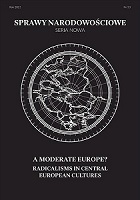The Cult of the Martyr: The Symbol of Stanisław Wacławski and Rituals of Violence in the Warsaw Student Milieu of the 1930s
The Cult of the Martyr: The Symbol of Stanisław Wacławski and Rituals of Violence in the Warsaw Student Milieu of the 1930s
Author(s): Izabela MrzygłódSubject(s): Political history, Social history, Studies in violence and power, Interwar Period (1920 - 1939), History of Antisemitism
Published by: Instytut Slawistyki Polskiej Akademii Nauk
Keywords: far-right; collective violence; antisemitism; interaction ritual chains; Stanisław Wacławski; students; interwar Poland;
Summary/Abstract: Violence was a key element of the interwar radical habitus and was particularly affirmed in far-right movements, which found fertile ground for their ideas among students. However, the influence of the systems of ideas advocated by ideologues on student masses seems limited and indirect. Student support for antisemitism and extremism cannot be explained only by cultural conditions, ideology or political engineering. What is needed here are intermediate stages, linking radical ideology with the actions of social actors. I argue that the intermediary function was performed by the symbol of Stanisław Wacławski, a student and member of the Camp of Great Poland (Obóz Wielkiej Polski) who was killed during the antisemitic riots in Vilnius in 1931. The figure of Wacławski was a key element of antisemitic discourse in far-right press and was used by academic societies to construct the annual ritual of violence in the 1930s. I employ the micro-sociological approach and draw on Randall Collins’ theory of “interaction ritual chains” to show that the factors behind the mobilization of ordinary students for collective violence and a chauvinistic agenda included also emotions and personal relations, and not only political identification and advertising.
Journal: Sprawy Narodowościowe
- Issue Year: 2021
- Issue No: 53
- Page Range: 1-22
- Page Count: 22
- Language: English

